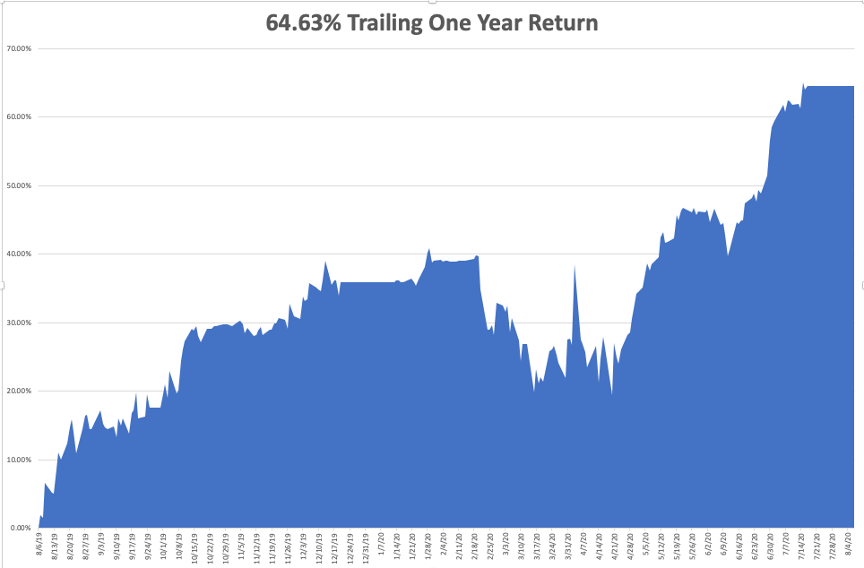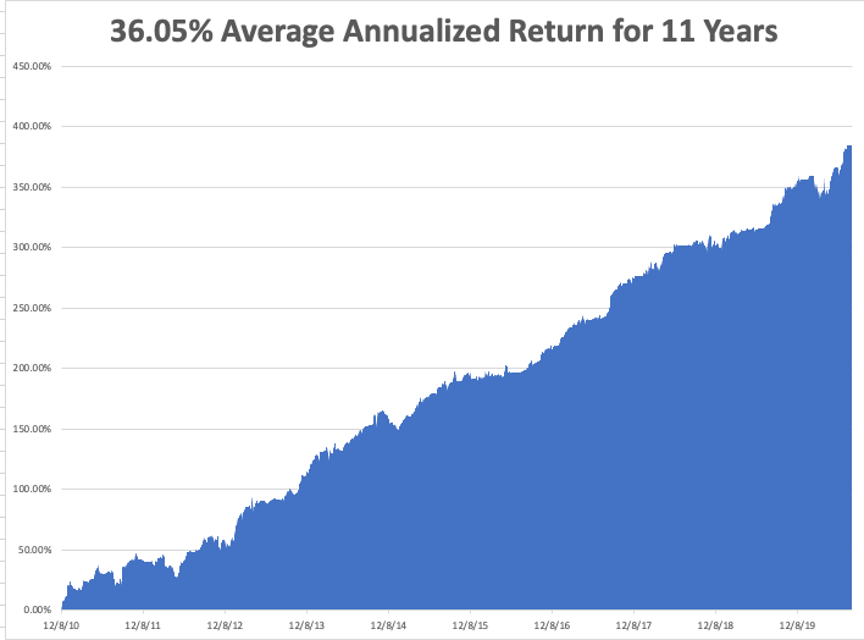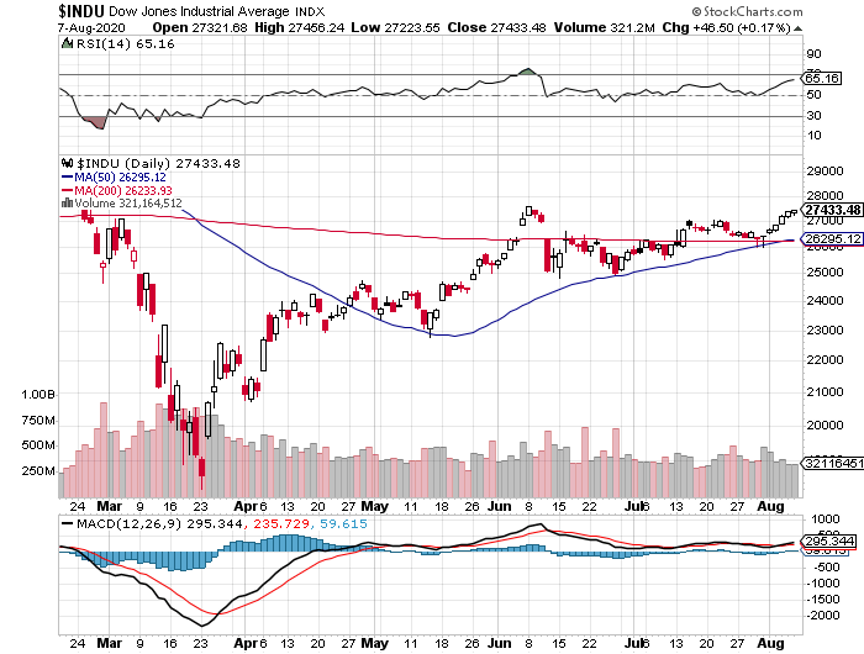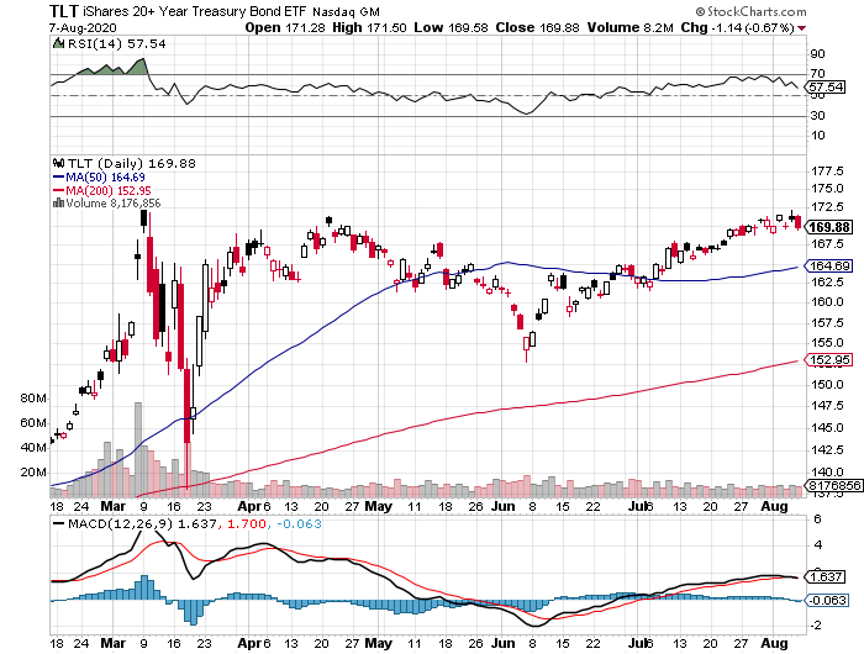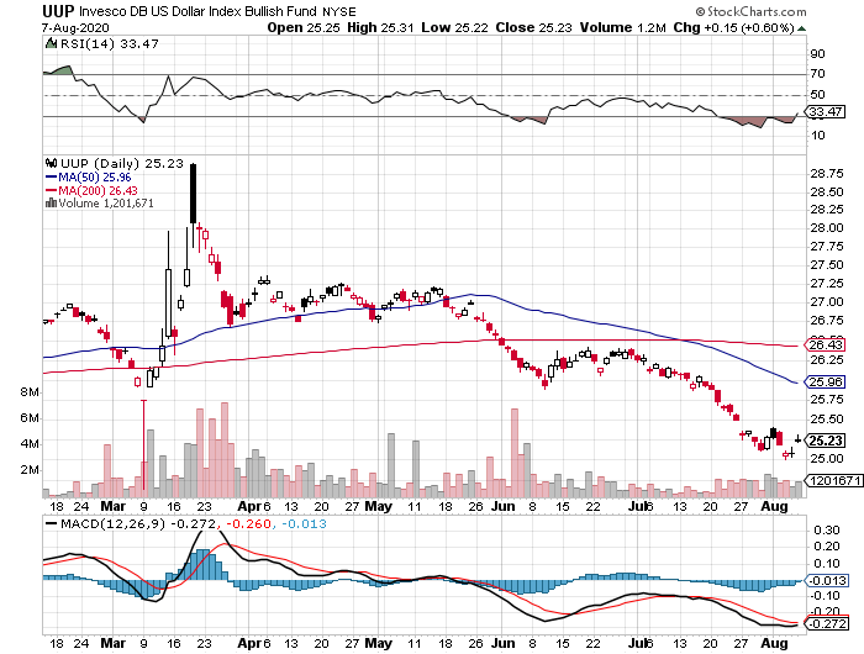I love this idea so much.. I just bought the September 260 to 285's calls.
Busy morning...
I thought it might be helpful to offer a factual summary of President Trump’s executive actions over the weekend, because I find it very difficult to get a straightforward accounting in most parts of the press of anything that has political implications, especially as election season heats up. I will also offer a few thoughts on the economic implications.
There were 4 executive orders, corresponding to several different elements of relief that had been offered by the CARES Act that had expired or will expire.
- Unemployment benefits. The $600 per week bonus unemployment benefits expired July 31. Republican Congressional negotiators insisted that $600/week was too generous, as total payments for over half of workers were higher than the wages that they were replacing, in some cases by quite a lot. Democrats were similarly adamant that the economy would collapse if the bonus payments were cut by any amount.
President Trump issued an executive order to continue paying $400 per week using money that was sitting around in other accounts (the payments will be retroactive to Aug. 1). The federal government will be directly responsible for $300 per week, using money from the Disaster Relief Fund, a fund that was created by the CARES Act and has about $70 billion remaining. The extra benefits will be paid until Dec. 6 or until $44 billion of the disaster fund is exhausted, whichever comes first. To put some rough numbers on it, if the number of beneficiaries holds in the neighborhood of 25 million, then payments would total about $7.5 billion per week, and the money would only last about 6 weeks. If the number of beneficiaries falls to 15 million, closer to the Household Survey level of unemployment, the weekly payout would be about $4.5 billion per week, and the money would last 10 weeks. Either way, the benefits would be exhausted in the heat of the election season, so if there is no deal with Congress, President Trump would presumably have to go looking for a different honey pot to, at a minimum, get past Election Day.
Meanwhile, states would be responsible for a quarter of the payments, $100 per week. States can tap from the $80 billion remaining in CARES Act money available to them to make the payments, and Secretary Mnuchin indicated today that all states have more than enough money available to make the payments (and Administration officials noted that if they run out, the federal government will find a way to help). In some ways, this rubs salt in the wounds for state governments, which were hoping for hundreds of billions of dollars in new funds in the unsuccessful fiscal package and are now going to have to use a chunk of what money is left over to make these payments.
- Eviction Moratorium. The second executive order does not reauthorize the eviction moratorium established in the CARES Act (which expired July 31). Instead, it directs Treasury and HUD to find money to provide temporary financial assistance to renters and homeowners who can’t meet their obligations. It also directs HUD to act to “promote the ability of renters and homeowners to avoid eviction or foreclosure.” Presumably, the FHFA and Fannie and Freddie will be enlisted to help as well. This one seems awfully fuzzy, but I would assume that regulators can find ways to roughly approximate the CARES Act status quo.
- Payroll tax holiday. This one strikes me as the most likely to not work. Trump directed the Treasury Dept. to defer the employee half of the Social Security tax on wages for those making less than $100,000 a year. The suspension would last from Sep. 1 to Dec. 31. President Trump will ask Congress to waive these obligations altogether, but short of legislative action, the taxes are merely deferred, not expunged. So, it is highly questionable whether firms would actually pass the money along to their workers, because it is the businesses that are on the hook for the taxes. If businesses pass the money on to their workers and then are forced to pay the taxes on Jan. 1, then it would be a messy affair to somehow go about clawing that money back from their workers. Moreover, even if businesses did pass the tax holiday funding along, it is doubtful that most households would spend the money, figuring that they would have to pay the money back 3 months later.
Thus, this gambit only works if Congress comes back and passes legislation that waives the payroll tax obligations for the four months. More importantly, it only works in real time if everyone believes now that Congress will do that over the next few months. Given that both Democrats and Republicans in Congress panned the idea of a payroll tax cut at the beginning of these negotiations, there is no reason for people to assume that.
I would offer one point on this executive order. Most of the commentary I have seen on this order, from both the press and from economists and analysts who should know better, is that it makes no sense to do this because it is the unemployed who need help, and a payroll tax cut only helps those who already have a job. This is simply a careless argument. Refer back to pt. 1 above. The government is already replacing lost wages for those who are unemployed. That is the help being offered specifically to the unemployed. The payroll tax executive order is an imperfect substitute for a second round of household rebate checks (which were sent to everyone, regardless of job status). Obviously, the President cannot unilaterally authorize another round of checks to households on his own, but he does have the authority to delay the payment of tax obligations (the same authority used to delay Tax Day to July 15), so that it is the point of this order. There are plenty of reasons to pan this executive order, but those making the “it doesn’t make sense to help those who already have jobs” argument are totally off-base.
- Student loan moratorium. The CARES Act gave borrowers a 6-month interruption of their monthly payments interest-free for federal student loans, which expires September 30. The executive order would extend the payment moratorium and zero interest until the end of the coronavirus crisis. To be clear, it only applies to federal student loans, not the old private loans with a federal guarantee. Most experts seem to believe that this is clearly illegal, but there is no plausible candidate to legally challenge the order. The only loser from this order would appear to be the federal government, so it is unclear who would bother to sue.
So, in my view there are two questions that we need to ask.
- If this is all there is, what is the economic impact? In my view, the extra unemployment benefits, as long as they last, will be plenty to keep consumers in good shape. A $400 per week bonus on unemployment benefits would still be offering wage replacement or better for a significant portion of the wage scale. Granted, President Trump would probably have to find a different honey pot to tap to keep the funds flowing through the election, but I would assume that the Administration is prepared to do so if necessary.
I suspect that cutting the size of the benefit will actually speed up the hiring recovery. Notwithstanding some politically-motivated, poorly-designed academic work that defies common sense, I have seen more than enough anecdotal evidence, including from the Fed, which is not exactly a bastion of conservative thinking, to be convinced that the generosity of benefits have encouraged many unemployed to politely decline when offered their job back (or a new job). If I am right, then this trimming of the benefits will be good for employment, though a marginal drag on consumption, AND it will limit the cost of the program, which would keep the money flowing longer.
The moratoria on evictions and student loans are likely to roughly keep the status quo in place. I am assuming that, for the most part, the payroll tax holiday would not be implemented by most businesses or spent by households, even if they get the money.
This leaves several key elements of what was generally assumed to be in a forthcoming package left on the sidelines. Both sides were on board for another round of rebate checks (which, as I have argued above, the payroll tax delay is a flawed attempt to replace). Both sides were on board for authorizing a second round of PPP loans for small businesses that can prove severe damage caused by the pandemic. Democrats and most Republicans agree that there should be some money for state and local governments. At a minimum, for example, it sounded like everyone was on board to provide at least $100 billion for education funding and money for various health costs (vaccine research, testing, etc.). So, there is no question that these executive orders are not a full substitute for a well-designed fiscal package. Even President Trump would presumably admit that. Nonetheless, unless the orders get challenged in court and struck down quickly, they will at least provide some portion of the benefits that have expired or will expire soon, enough to allow the economy to continue to climb out of the huge hold caused by the virus and the resulting lockdowns.
- Do the executive orders make an eventual deal more or less likely? As I indicated throughout these negotiations, the Democrats thought they held all of the leverage and were prepared to play hard ball throughout. When they took this hard line, I doubt that Speaker Pelosi and Sen. Schumer thought President Trump would go through with these legally-dubious executive orders, which, while they may not be legal, offer huge political upside to Trump and will be politically difficult for Democrats to challenge in court (“they are trying to take away your benefits”). This is a terrible way to run the government, but as a political gambit, the orders do shift the leverage back toward the middle, or maybe even in President Trump’s favor. Now, Democrats have an added incentive to do a deal, because otherwise these executive orders will set a precedent that future Presidents can go around Congress in a pinch.
Secretary Mnuchin was on CNBC this morning, and he was arguing that the two sides should pass what they agree on, specifically funding for schools and a second round of PPP loans (and I would add household rebate checks and maybe some extra money for state and local governments). Democrats never wanted a piecemeal solution, because so much of the $3 trillion plus that they were asking for was difficult to justify on a stand-alone basis as a direct response to the pandemic or as proportional to the immediate need. So far, neither side seems all that eager to rush back to the negotiating table, but I still believe that the two sides will ultimately strike some sort of a deal, though it may take most of August to get there. I would also opine that whatever deal is negotiated will have a significantly smaller total price tag than what Pelosi and Schumer thought they could get last week.
Stay tuned.


